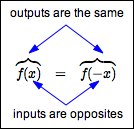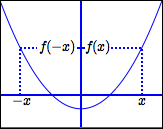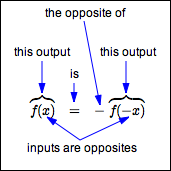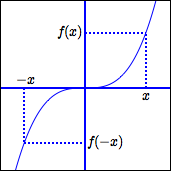 Even and Odd Functions
Even and Odd Functions
Even Functions
A function $\,f\,$ is even
if and only if
for all $\,x\,$ in the domain of $\,f\,,$
$\,f(x) = f(-x)\,.$
For even functions: when inputs are opposites, the corresponding outputs are the same.


-
Recall that $\,x\,$ and $\,-x\,$ are opposites.
When $\,x\,$ is the input, $\,f(x)\,$ is the output.
When $\,-x\,$ is the input, $\,f(-x)\,$ is the output.
For even functions, these two outputs must be equal.
-
Note: A function $\,f\,$ is even if and only if the graph of $\,f\,$ is symmetric about the $y$-axis.
-
Note: $\,y = x^2\,,$ $\,y = x^4\,,$ $\,y = x^6\,,$ $\,y = x^8\,,$ etc., are all even functions. Thus, power functions with even powers are even functions! So, the name ‘even’ seems reasonable.
-
There are lots of other even functions. For example, $\,y = |x|\,$ and $\,y = \cos(x)\,$ are even functions.
-
Is $\,g(t) = t^2 - t^4\,$ an even function?
You must investigate $\,g(-t)\,,$ and compare it with $\,g(t)\,,$ as follows:
$$ \begin{align} \cssId{s28}{g(-t)} &\cssId{s29}{=} \cssId{s30}{(-t)^2 - (-t)^4}\cr &\quad\cssId{s31}{\text{(definition of $\,g\,$; function evaluation)}}\cr\cr &\cssId{s32}{=} \cssId{s33}{t^2 - t^4}\cr &\quad\cssId{s34}{\text{(simplify)}}\cr\cr &\cssId{s35}{=} \cssId{s36}{g(t)}\cr &\quad\cssId{s37}{\text{(definition of $g$)}} \end{align} $$Thus, $\,g\,$ is an even function.
Odd Functions
A function $\,f\,$ is odd
if and only if
for all $\,x\,$ in the domain of $\,f\,,$
$\,f(x) = -f(-x)\,.$
For odd functions: when inputs are opposites, the corresponding outputs are opposites.


-
Recall that $\,x\,$ and $\,-x\,$ are opposites.
When $\,x\,$ is the input, $\,f(x)\,$ is the output.
When $\,-x\,$ is the input, $\,f(-x)\,$ is the output.
For odd functions, these two outputs must be opposites.
-
Observe that ‘$\,f(x) = -f(-x)\,$’ is equivalent to ‘$\,f(-x) = -f(x)\,$’ (multiply both sides by $\,-1\,$ and switch sides).
Sometimes, the definition is given using this equivalent characterization.
-
Note: A function $\,f\,$ is odd if and only if the graph of $\,f\,$ is symmetric about the origin.
-
Note: $\,y = x\,,$ $\,y = x^3\,,$ $\,y = x^5\,,$ $\,y = x^7\,,$ $\,y = x^9\,,$ etc., are all odd functions. Thus, power functions with odd powers are odd functions! So, the name ‘odd’ seems reasonable.
-
There are lots of other odd functions. For example, $\,y = \frac{1}{x}\,$ and $\,y = \sin(x)\,$ are odd functions.
-
Is $\,g(x) = x^3 - 1\,$ an odd function?
That is, are $\,g(-x)\,$ and $\,g(x)\,$ opposites?
That is, are $\,g(-x)\,$ and $\,-g(x)\,$ equal?
$$\cssId{s72}{g(-x)} \cssId{s73}{= (-x)^3 - 1} \cssId{s74}{= -x^3 - 1}$$Find $\,g(-x)\,$:
definition of $\,g\,$; function evaluation.$$\cssId{s77}{-g(x)} \cssId{s78}{= -(x^3-1)} \cssId{s79}{= -x^3 + 1}$$Find the opposite of $\,g(x)\,$:
definition of $\,g\,$; the distributive law.Since $\,g(-x)\,$ and $\,-g(x)\,$ are different, $\,g\,$ is not an odd function.
-
If an odd function is defined at zero, then its graph must pass through the origin. Why?
If $\,f\,$ is odd and defined at zero, then:
$f(x) = -f(-x)$ Requirement for an odd function $f(0) = -f(-0)$ Let $\,x = 0$ $f(0) = -f(0)$ The opposite of zero is zero $2f(0) = 0$ Add $\,f(0)\,$ to both sides $f(0) = 0$ Divide both sides by $\,2$